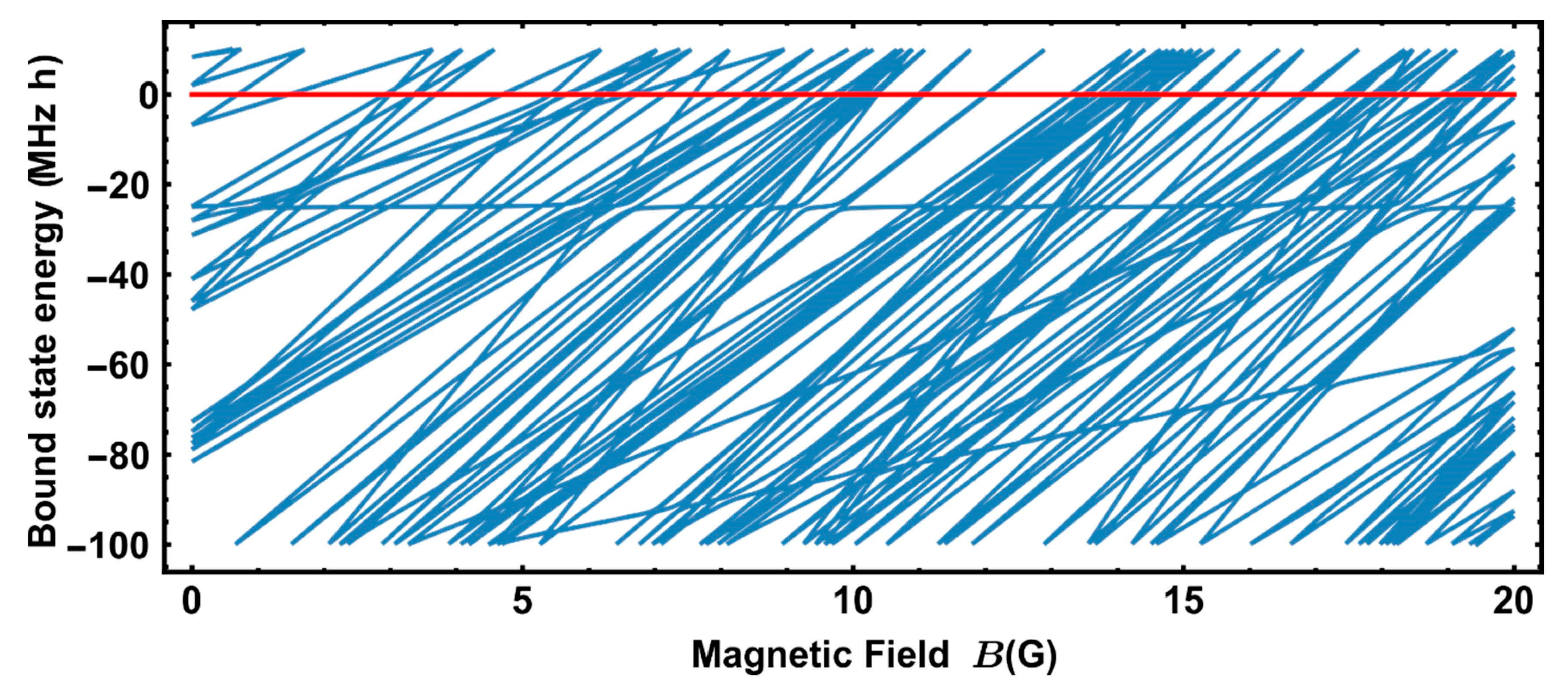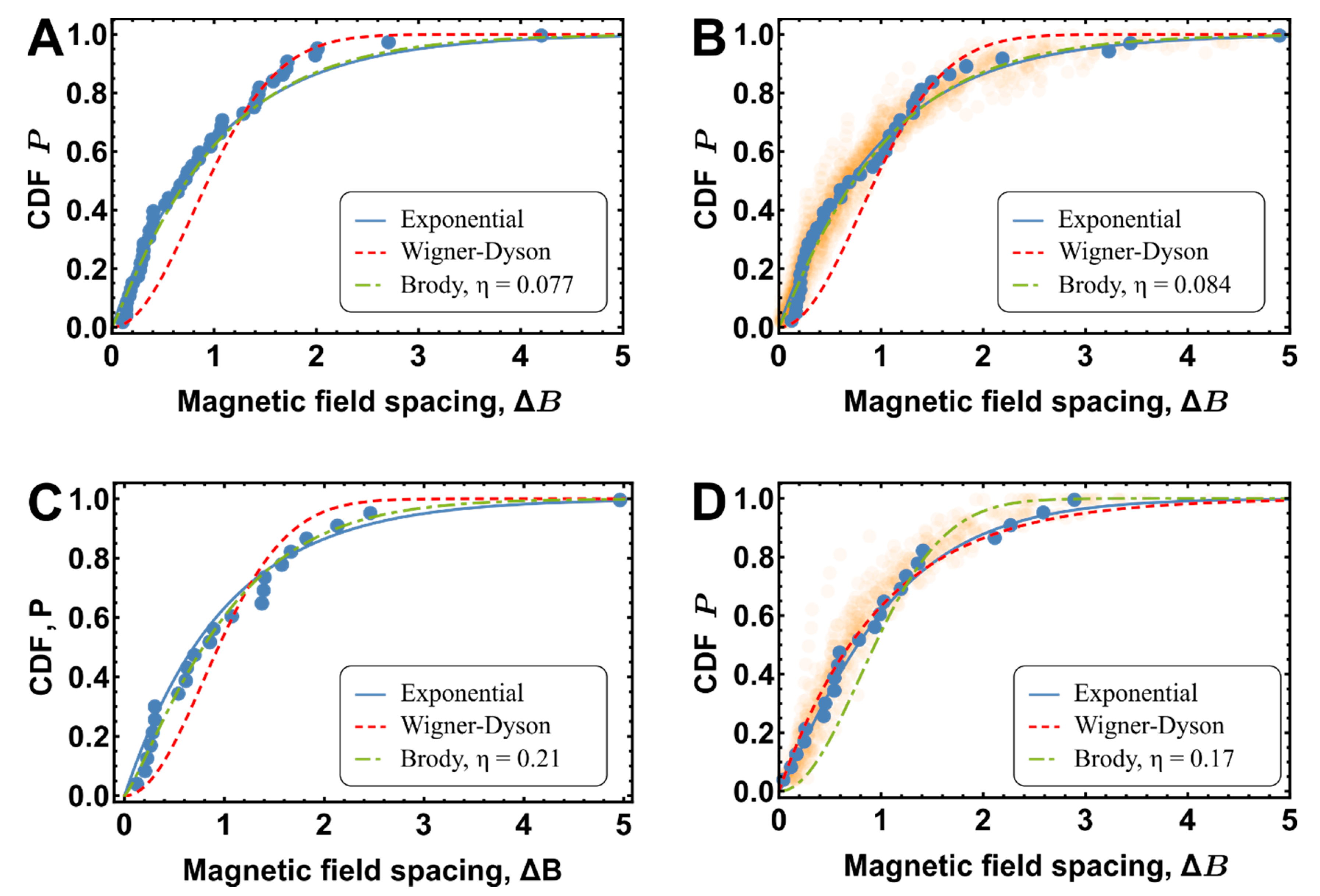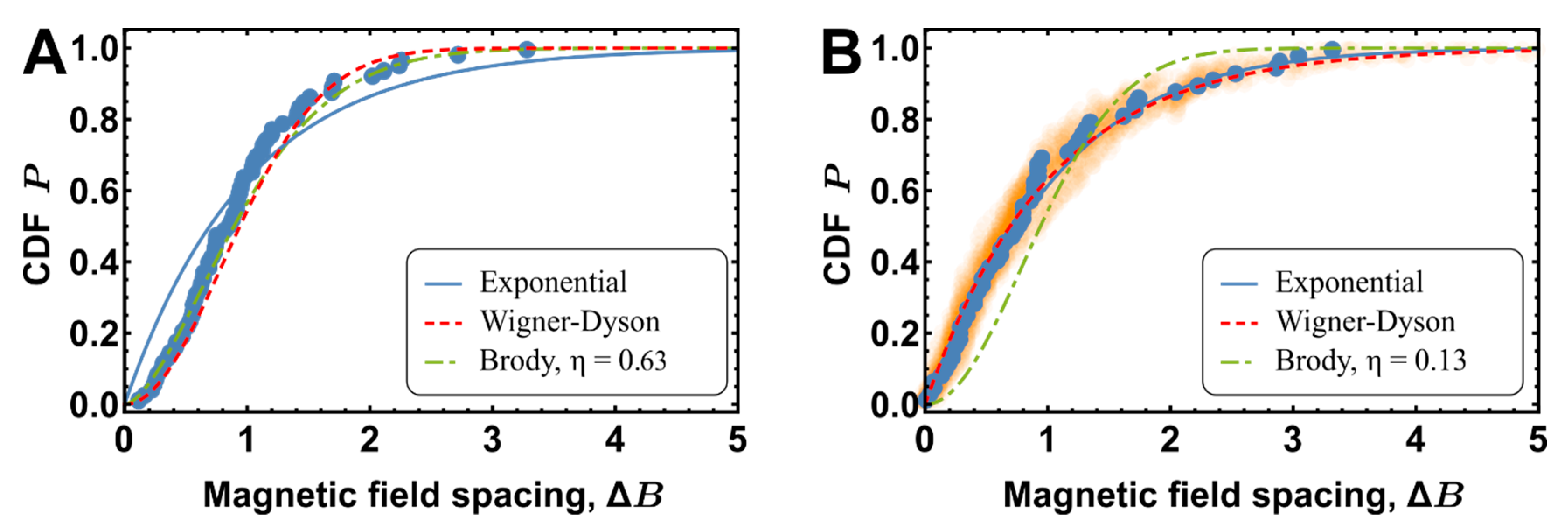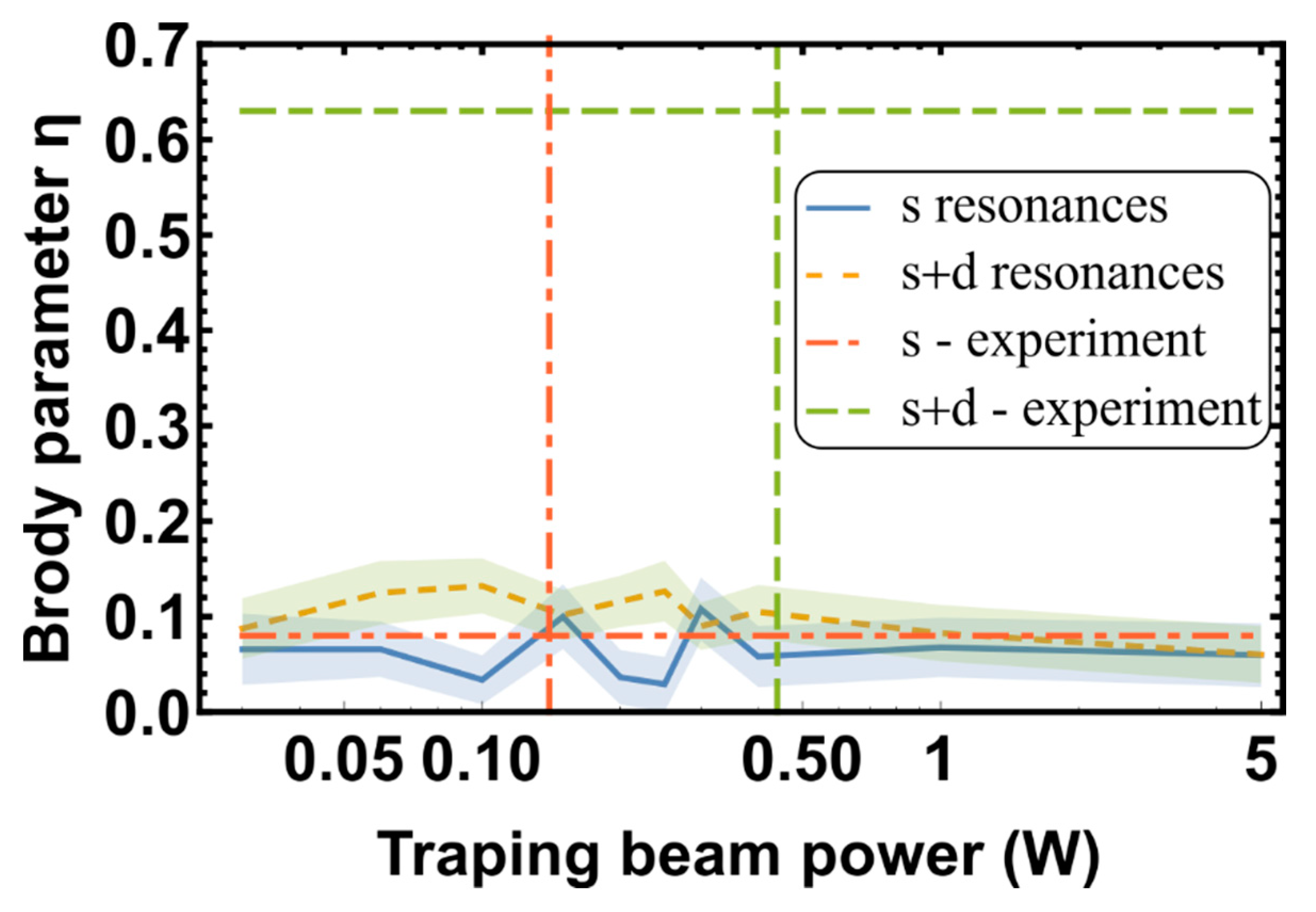Random Matrix Theory Analysis of a Temperature-Related Transformation in Statistics of Fano–Feshbach Resonances in Thulium Atoms
Abstract
1. Introduction
2. Materials and Methods
3. Results
4. Discussion
5. Conclusions
Supplementary Materials
Author Contributions
Funding
Conflicts of Interest
References
- Kotochigova, S. Controlling interactions between highly magnetic atoms with Feshbach resonances. Rep. Prog. Phys. 2014, 77, 093901. [Google Scholar] [CrossRef]
- Chin, C.; Grimm, R.; Julienne, P.; Tiesinga, E. Feshbach resonances in ultracold gases. Rev. Mod. Phys. 2010, 82, 1225–1286. [Google Scholar] [CrossRef]
- Jochim, S.; Bartenstein, M.; Hendl, G.; Denschlag, J.H.; Grimm, R.; Mosk, A.; Weidemüller, M. Magnetic Field Control of Elastic Scattering in a Cold Gas of Fermionic Lithium Atoms. Phys. Rev. Lett. 2002, 89. [Google Scholar] [CrossRef] [PubMed]
- Zenesini, A.; Huang, B.; Berninger, M.; Nägerl, H.-C.; Ferlaino, F.; Grimm, R. Resonant atom-dimer collisions in cesium: Testing universality at positive scattering lengths. Phys. Rev. A 2014, 90, 022704. [Google Scholar] [CrossRef]
- Inouye, S.; Andrews, M.R.; Stenger, J.; Miesner, H.-J.; Stamper-Kurn, D.M.; Ketterle, W. Observation of Feshbach resonances in a Bose-Einstein condensate. Nature 1998, 392, 151–154. [Google Scholar] [CrossRef]
- Duarte, P.M.; Hart, R.A.; Yang, T.L.; Liu, X.; Paiva, T.; Khatami, E.; Scalettar, R.T.; Trivedi, N.; Hulet, R.G. Compressibility of a fermionic mott insulator of ultracold atoms. Phys. Rev. Lett. 2015, 114. [Google Scholar] [CrossRef] [PubMed]
- Bloch, I.; Dalibard, J.; Nascimbène, S. Quantum simulations with ultracold quantum gases. Nat. Phys. 2012, 8, 267–276. [Google Scholar] [CrossRef]
- Baier, S.; Mark, M.J.; Petter, D.; Aikawa, K.; Chomaz, L.; Cai, Z.; Baranov, M.; Zoller, P.; Ferlaino, F. Extended Bose-Hubbard models with ultracold magnetic atoms. Science 2016, 352, 201–205. [Google Scholar] [CrossRef]
- Maier, T.; Kadau, H.; Schmitt, M.; Wenzel, M.; Ferrier-Barbut, I.; Pfau, T.; Frisch, A.; Baier, S.; Aikawa, K.; Chomaz, L.; et al. Emergence of Chaotic Scattering in Ultracold Er and Dy. Phys. Rev. X 2015, 5, 041029. [Google Scholar] [CrossRef]
- Khlebnikov, V.A.; Pershin, D.A.; Tsyganok, V.V.; Davletov, E.T.; Cojocaru, I.S.; Fedorova, E.S.; Buchachenko, A.A.; Akimov, A.V. Random to Chaotic Statistic Transformation in Low-Field Fano-Feshbach Resonances of Cold Thulium Atoms. Phys. Rev. Lett. 2019, 123, 213402. [Google Scholar] [CrossRef]
- Frisch, A.; Mark, M.; Aikawa, K.; Ferlaino, F.; Bohn, J.L.; Makrides, C.; Petrov, A.; Kotochigova, S. Quantum chaos in ultracold collisions of gas-phase erbium atoms. Nature 2014, 507, 475–479. [Google Scholar] [CrossRef] [PubMed]
- Blümel, R.; Reinhardt, W.P. Chaos in Atomic Physics; Cambridge University Press: Cambridge, UK, 1997. [Google Scholar]
- Flambaum, V.V.; Gribakina, A.A.; Gribakin, G.F. Statistics of electromagnetic transitions as a signature of chaos in many-electron atoms. Phys. Rev. A-At. Mol. Opt. Phys. 1998, 58, 230–237. [Google Scholar] [CrossRef]
- Flambaum, V.V.; Kozlov, M.G.; Gribakin, G.F. Coherent and stochastic contributions of compound resonances in atomic processes: Electron recombination, photoionization, and scattering. Phys. Rev. A-At. Mol. Opt. Phys. 2015, 91, 052704. [Google Scholar] [CrossRef]
- Friedrich, H.; Wintgen, H. The hydrogen atom in a uniform magnetic field—An example of chaos. Phys. Rep. 1989, 183, 37–79. [Google Scholar] [CrossRef]
- Braaten, E.; Hammer, H.W. Universality in few-body systems with large scattering length. Phys. Rep. 2006, 428, 259–390. [Google Scholar] [CrossRef]
- Suno, H.; Esry, B.D.; Greene, C.H.; Burke, J.P. Three-body recombination of cold helium atoms. Phys. Rev. A 2002, 65, 042725. [Google Scholar] [CrossRef]
- Beaufils, Q.; Crubellier, A.; Zanon, T.; Laburthe-Tolra, B.; Maréchal, E.; Vernac, L.; Gorceix, O. Feshbach resonance in d -wave collisions. Phys. Rev. A 2009, 79, 032706. [Google Scholar] [CrossRef]
- Wang, J.; D’Incao, J.P.; Wang, Y.; Greene, C.H. Universal three-body recombination via resonant d-wave interactions. Phys. Rev. A-At. Mol. Opt. Phys. 2012, 86, 1–8. [Google Scholar] [CrossRef]
- Moerdijk, A.J.; Verhaar, B.J.; Axelsson, A. Resonances in ultracold collisions of Li6, Li7, and Na23. Phys. Rev. A 1995, 51, 4852–4861. [Google Scholar] [CrossRef]
- Sakurai, J.J. Advanced Quantum Mechanics; Addison-Wesley Pub. Co.: Reading, MA, USA, 1967; ISBN 0201067102. [Google Scholar]
- Guhr, T.; Müller–Groeling, A.; Weidenmüller, H.A. Random-matrix theories in quantum physics: Common concepts. Phys. Rep. 1998, 299, 189–425. [Google Scholar] [CrossRef]
- Dyson, F.J.; Lal Mehta, M. Statistical theory of the energy levels of complex systems. IV. J. Math. Phys. 1963, 4, 701–712. [Google Scholar] [CrossRef]
- Augustovičová, L.D.; Bohn, J.L. Manifestation of quantum chaos in Fano-Feshbach resonances. Phys. Rev. A 2018, 98, 023419. [Google Scholar] [CrossRef]
- Tsyganok, V.V.; Pershin, D.A.; Davletov, E.T.; Khlebnikov, V.A.; Akimov, A.V. Scalar, tensor, and vector polarizability of Tm atoms in a 532-nm dipole trap. Phys. Rev. A 2019, 100, 042502. [Google Scholar] [CrossRef]
- Tsyganok, V.V.; Khlebnikov, V.A.; Kalganova, E.S.; Pershin, D.A.; Davletov, E.T.; Cojocaru, I.S.; Luchnikov, I.A.; Berezutskii, A.V.; Bushmakin, V.S.; Sorokin, V.N.; et al. Polarized cold cloud of thulium atom. J. Phys. B At. Mol. Opt. Phys. 2018, 51, 165001. [Google Scholar] [CrossRef]
- Brody, T.A.; Flores, J.; French, J.B.; Mello, P.A.; Pandey, A.; Wong, S.S.M. Random-matrix physics: Spectrum and strength fluctuations. Rev. Mod. Phys. 1981, 53, 385–479. [Google Scholar] [CrossRef]




| Mean Bound States Energy Spacings | Coupling Parameter, | Trapping Beam Power, W | Magnetic Field Range | Magnetic Field Discretization | Number of Simulations | Number of Bound States | Density, | Brody Parameter, | |
|---|---|---|---|---|---|---|---|---|---|
| S | 5.6 | 0.7 | 0 | 20 | 2000 | 30 | 500 | 2.1 ± 0.4 | 0.07 ± 0.03 |
| D | 10.7 | 2.9 | 0 | 20 | 2000 | 30 | 500 | 1.0 ± 0.2 | 0.18 ± 0.05 |
| Mean Bound States Energy Spacings | Coupling Parameter, | Trapping Beam Power, W | Magnetic Field Range | Magnetic Field Discretization | Number of Simulations | Number of Bound States | Density, | Brody Parameter, (RMT) | Brody Parameter, (Experimental) | |
|---|---|---|---|---|---|---|---|---|---|---|
| S | 5.6 | 0.7 | 0.15 | 20 | 2000 | 30 | 500 | 2.1 ± 0.4 | 0.1 ± 0.04 | 0.08 |
| S+D | 5.6, 10.7 | 0.7, 2.9 | 0.4 | 20 | 2000 | 30 | 500 | 3.1 ± 0.4 | 0.1 ± 0.03 | 0.63 |
Publisher’s Note: MDPI stays neutral with regard to jurisdictional claims in published maps and institutional affiliations. |
© 2020 by the authors. Licensee MDPI, Basel, Switzerland. This article is an open access article distributed under the terms and conditions of the Creative Commons Attribution (CC BY) license (http://creativecommons.org/licenses/by/4.0/).
Share and Cite
Davletov, E.T.; Tsyganok, V.V.; Khlebnikov, V.A.; Pershin, D.A.; Akimov, A.V. Random Matrix Theory Analysis of a Temperature-Related Transformation in Statistics of Fano–Feshbach Resonances in Thulium Atoms. Entropy 2020, 22, 1394. https://doi.org/10.3390/e22121394
Davletov ET, Tsyganok VV, Khlebnikov VA, Pershin DA, Akimov AV. Random Matrix Theory Analysis of a Temperature-Related Transformation in Statistics of Fano–Feshbach Resonances in Thulium Atoms. Entropy. 2020; 22(12):1394. https://doi.org/10.3390/e22121394
Chicago/Turabian StyleDavletov, Emil T., Vladislav V. Tsyganok, Vladimir A. Khlebnikov, Daniil A. Pershin, and Alexey V. Akimov. 2020. "Random Matrix Theory Analysis of a Temperature-Related Transformation in Statistics of Fano–Feshbach Resonances in Thulium Atoms" Entropy 22, no. 12: 1394. https://doi.org/10.3390/e22121394
APA StyleDavletov, E. T., Tsyganok, V. V., Khlebnikov, V. A., Pershin, D. A., & Akimov, A. V. (2020). Random Matrix Theory Analysis of a Temperature-Related Transformation in Statistics of Fano–Feshbach Resonances in Thulium Atoms. Entropy, 22(12), 1394. https://doi.org/10.3390/e22121394





